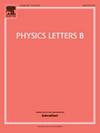Quenching of the weak axial coupling derived from the scattering of stopped-pion neutrinos on 127I
IF 4.3
2区 物理与天体物理
Q1 ASTRONOMY & ASTROPHYSICS
引用次数: 0
Abstract
The need for quenching of the weak axial-vector coupling in calculations involving weak processes in nuclei is a well-known and long-standing problem arising from several contributing factors. Theoretical studies in momentum exchanges beyond that of typical β decays have been hindered in the past by lack of experimental results. To this end, the recent measurement of inelastic scattering cross section of electron neutrinos from the stopped-pion neutrino source at Oak Ridge National Laboratory (ORNL), impinging on 127I, by the COHERENT collaboration [P. An et al., Phys. Rev. Lett. 131, 221801 (2023)] offers a rare opportunity for such a study. We compute this cross section by employing the microscopic quasiparticle-phonon model, based on nuclear excitations produced by the quasiparticle random-phase approximation (QRPA) and the related microscopic effective Hamiltonian based on a G-matrix approach. In the computations we include the meson-exchange two-body currents at the level of effective one-body currents. Comparison of the measured and computed cross sections allows us for the first time to go beyond the β-decay studies of P. Gysbers et al. [Nat. Phys. 15, 428 (2019)] in separating the contributions coming from the two-body currents and the nuclear many-body approach to the quenching of the weak axial-vector coupling for a medium-mass open-shell nucleus in a momentum-exchange region relevant for, e.g., the neutrinoless double β decay.
127I上停止介子中微子散射引起的弱轴向耦合的猝灭
在涉及核弱过程的计算中,需要对弱轴矢量耦合进行猝灭是一个众所周知的长期存在的问题,这是由几个因素引起的。在过去,由于缺乏实验结果,对典型β衰变以外的动量交换的理论研究受到了阻碍。为此,美国橡树岭国家实验室(ORNL)停止介子中微子源对127I碰撞的电子中微子的非弹性散射截面的最新测量[P。等等,物理学家。Rev. Lett. 131, 221801(2023)]为这样的研究提供了难得的机会。我们采用微观准粒子-声子模型,基于准粒子随机相近似(QRPA)产生的核激发和基于g矩阵方法的相关微观有效哈密顿量来计算该横截面。在计算中,我们将介子交换的二体电流包括在有效一体电流的水平上。测量截面和计算截面的比较使我们第一次超越了P. Gysbers等人的β衰变研究[Nat. Phys. 15,428(2019)],分离了来自两体电流和核多体方法的贡献,这些贡献来自于与动量交换区域相关的中等质量开壳核的弱轴矢量耦合gA的猝灭,例如,中微子双β衰变。
本文章由计算机程序翻译,如有差异,请以英文原文为准。
求助全文
约1分钟内获得全文
求助全文
来源期刊

Physics Letters B
物理-物理:综合
CiteScore
9.10
自引率
6.80%
发文量
647
审稿时长
3 months
期刊介绍:
Physics Letters B ensures the rapid publication of important new results in particle physics, nuclear physics and cosmology. Specialized editors are responsible for contributions in experimental nuclear physics, theoretical nuclear physics, experimental high-energy physics, theoretical high-energy physics, and astrophysics.
 求助内容:
求助内容: 应助结果提醒方式:
应助结果提醒方式:


